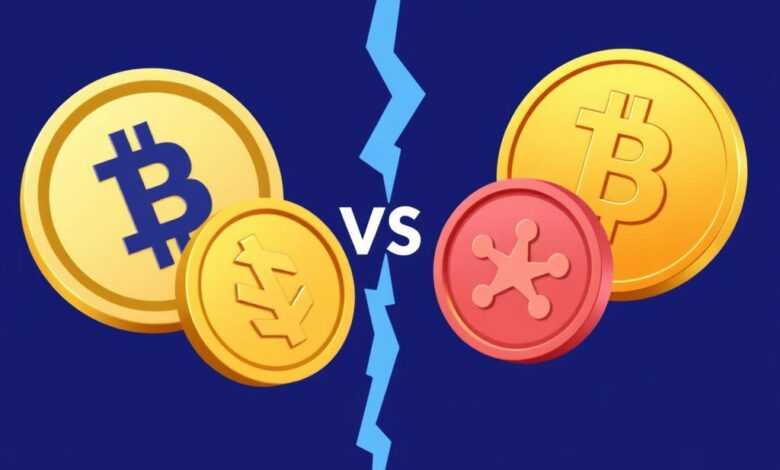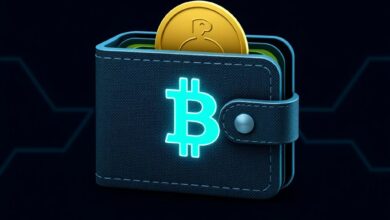Tokens vs coins – what’s the difference

For anyone engaged in cryptocurrency, a clear distinction between tokens and coins is imperative. Coins typically serve as digital currency on their own blockchain, enabling transactions and acting as a medium of exchange. In contrast, tokens exist on existing blockchains, often representing assets or utilities within specific platforms or applications.
An explanation of these concepts reveals that while coins are often associated with cryptocurrencies like Bitcoin or Ethereum, tokens can vary widely in purpose. They might represent voting rights in decentralized finance (DeFi) projects or even signify ownership of real-world assets through tokenization.
Recognizing these nuances not only aids in informed investment decisions but also enhances understanding of how various crypto instruments function within the broader ecosystem. By grasping this distinction, one can navigate the complex world of digital assets with greater confidence and clarity.
Characteristics of Cryptocurrency Coins
Coins serve specific functions within their networks, primarily as a medium of exchange. They are often used for transactions and trading, facilitating the transfer of value between parties.
Typically built on their own blockchain, these assets offer security and decentralization. This infrastructure ensures that transactions are recorded immutably, providing transparency and trust among users.
Cryptocurrency coins usually have a capped supply, influencing scarcity and potentially increasing value over time. This characteristic attracts investors seeking long-term appreciation.
Utility is another defining trait; many coins provide additional functionalities within their ecosystems. For instance, they may enable staking or governance rights, allowing holders to participate in decision-making processes.
Market capitalization plays a significant role in evaluating these digital assets. Coins with higher market caps tend to reflect greater stability and investor confidence, while lower-cap options can lead to more volatility but offer high-risk, high-reward opportunities.
The consensus mechanism utilized by coins also differentiates them. Proof of Work (PoW) and Proof of Stake (PoS) are common methods ensuring network security while validating transactions efficiently.
Investors should also consider liquidity; widely accepted coins generally exhibit higher trading volumes. This feature enhances the ease of buying or selling without significantly affecting price.
A thorough understanding of the unique characteristics of cryptocurrency coins enables informed decisions when navigating the crypto market landscape.
How Tokens Function in Ecosystems
Tokens serve specific roles within blockchain ecosystems, often representing assets or utilities that facilitate interactions among users. They can act as access keys to decentralized applications, granting holders the ability to utilize services or features without needing traditional currencies.
A key explanation of token functionality lies in their programmability. Smart contracts enable automated transactions and operations based on predefined conditions, allowing tokens to be integrated seamlessly into various applications like DeFi platforms or NFT marketplaces. This programmability distinguishes them from conventional currencies by adding layers of functionality.
Moreover, tokens can represent a wide variety of assets, ranging from real estate to virtual goods. This versatility provides investors with opportunities for diversification, as they can acquire exposure to different markets without the need for direct ownership of underlying assets.
In many cases, tokens are created through Initial Coin Offerings (ICOs) or Token Generation Events (TGEs), where developers issue them to raise funds for projects. This process is pivotal in driving innovation and development within crypto spaces, allowing new ideas to flourish quickly.
Additionally, governance tokens give holders voting rights on project decisions, influencing future developments and changes within an ecosystem. This democratic approach empowers users and fosters community engagement.
The liquidity of tokens also plays a significant role in their utility. Many exchanges support trading pairs with fiat and other cryptocurrencies, enabling users to easily buy, sell or trade assets as market conditions fluctuate. This liquidity enhances the overall functioning of blockchain networks.
In summary, tokens enhance ecosystems through their utility, programmability, asset representation capabilities, and governance features. Understanding how these digital instruments operate is crucial for navigating the evolving landscape of cryptocurrency investments.
Investment Implications for Coins
Investing in crypto assets like coins requires a strategic approach. Consider these key points:
- Market Capitalization: Focus on coins with substantial market caps. They generally indicate stability and broader acceptance.
- Liquidity: Ensure high liquidity to facilitate easier buying and selling without significant price impact.
- Technology and Use Case: Analyze the underlying technology. Coins that support advanced features or solve real-world problems often have higher growth potential.
- Regulatory Environment: Monitor regulations affecting specific currencies. Compliance can enhance longevity and investor confidence.
Diversification is essential. Allocate funds across various crypto assets to mitigate risks associated with volatility in individual coins.
- Long-Term vs Short-Term: Define your investment horizon. Long-term holders may benefit from market cycles, while short-term traders need to stay updated on trends and news.
- Technical Analysis: Utilize chart patterns and indicators to identify entry and exit points effectively.
- Community Engagement: Participate in forums or social media channels related to specific coins. Community sentiment can provide insights into future performance.
Avoid emotional decisions; base actions on research and analysis instead. As you explore these digital assets, focus on informed strategies that align with your financial goals.
Use Cases for Cryptocurrency Tokens
Crypto assets serve various functions within blockchain ecosystems, providing innovative solutions across multiple sectors. One prevalent application is in decentralized finance (DeFi), where tokens facilitate lending, borrowing, and trading without intermediaries. Users can earn interest or yield farming rewards by providing liquidity.
Another significant use case lies in non-fungible tokens (NFTs), representing ownership of unique digital items such as art, music, and virtual real estate. This has transformed how creators monetize their work while enabling collectors to verify authenticity through blockchain technology.
Additionally, utility tokens grant holders access to specific services within a platform. For example, users may purchase subscriptions or pay for transaction fees using these tokens, fostering a thriving economy around the underlying project.
Governance is another critical area; many projects utilize tokens to enable holders to vote on proposals and influence development directions. This decentralized decision-making process enhances community engagement and aligns interests among participants.
Lastly, loyalty programs increasingly incorporate crypto tokens as rewards for customer engagement and purchases. Businesses leverage these assets to incentivize repeat transactions while enhancing brand loyalty through transparent reward systems.







